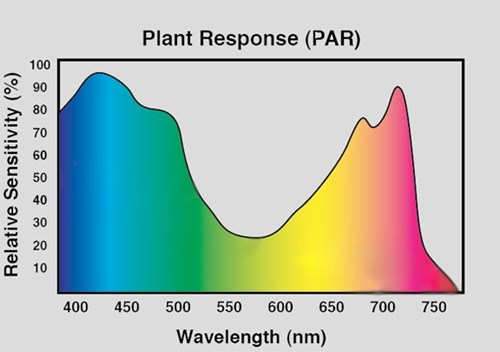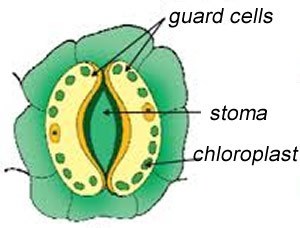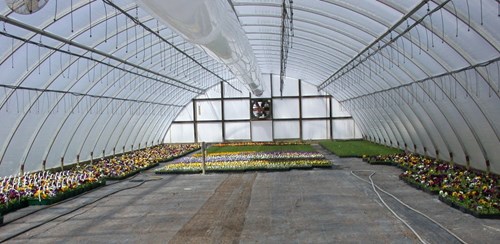Basics of Photosynthesis


Photosynthesis is a chemical reaction through which plants absorb light and transform it into sugars and oxygen. It is a highly complex process that is vital to nearly all organisms on Earth. But exactly how does it work?
Plants are autotrophic organisms, which means that plants produce their own food and they support other organisms. Without the sun, photosynthesis would stop and no life could be sustained.
Photosynthesis is the chemical reaction where carbon dioxide (CO2) and water form sugars and oxygen in the presence of light energy. The sugars formed by photosynthesis are used by the plants as a food energy source. Under natural conditions, the sun provides the energy to trigger photosynthesis.
Plants use a specific portion of the solar (light) spectrum for photosynthesis, which is called Photosynthetic Active Radiation (PAR) (Figure1). PAR is the region of the solar radiation between 400 and 700 nm.

Why Are Leaves Green?
It is incredible, but less than 5% of the energy emitted by the sun is used for photosynthesis. In plants, the photosynthesis process takes place in the chloroplasts within plant cells. This organ contains the pigment chlorophyll (green pigment) which is in charge of absorbing the light from the sun. Plants contain both chlorophyll a, which absorbs mostly violet and red light, and chlorophyll b, which absorbs blue and red light.
Both types of chlorophyll reflect green light, which is the reason why leaves look green. The chlorophyll b and carotenoids (another pigment in the chloroplast) are called accessory pigments. The chloroplasts which contain the chlorophyll are in membranes called thylakoids. The general equation for photosynthesis is:
6CO2 + 6H2O + energy → C6H12O6 + 6O2
Stomates
Photosynthesis occurs mostly in the leaves of the plant; however, it can occur in the stems, but in a minimal proportion. It begins when CO2 enters the leaf through the stomata (openings in the leaves) (Figure 2). Most of the stomata are located on the underside of the leaf to avoid excessive water loss. Stomata allow for the exchange of CO2, oxygen and water vapor between the leaf and the environment.

Photosynthesis: A 2-Step Process
The process of photosynthesis occurs in two steps, which are the light-dependent reaction and the light-independent reaction. The light-dependent reaction (light is required) takes place in the thylakoids and converts light into chemical energy. The chemical energy produced in the light-dependent reaction is then used to fix CO2 into carbohydrates, which is the light-independent reaction, or Calvin cycle. The Calvin cycle occurs in the stroma of the chloroplast. The by-products of these reactions are glucose, which is used by the plant, and oxygen, which is released into the atmosphere through the stomata.
Plants differ in the pathway to fix CO2; as a consequence, the light-independent reactions can be classified as pathway C3, pathway C4 and pathway CAM. C3 plants are adapted to temperate climates while C4 plants are adapted to hot, dry climates. The CAM plants are mostly cacti; they open the stomata at night to reduce the loss of water by transpiration.
Factors Influencing Photosynthesis
Light Quality
As mentioned before, plants photosynthesize while they are exposed to PAR radiation; this refers to light quality (Figure 1). As mentioned before, chlorophyll more efficiently absorbs violet-blue light and red light. Therefore, it is preferable to expose plants to this light quality, at a certain intensity (amount of energy). When choosing supplemental lighting and especially working solely with artificial light, it is important to choose the right light source.
For example, incandescent bulbs have low efficiency since most of the energy is used to heat the lamp; in addition, most of the light energy is provided in the red region. High Pressure Sodium lamps (HPS) and Light-Emitting Diodes (LED) are the most efficient light sources on the market. HPS lamps have two peaks in the PAR region, one small in the blue and a larger one that spans the yellow, orange and red regions of the spectrum.
Light Intensity
Regardless of the light energy source, plants need a minimum light intensity to trigger the photosynthesis process; this point is called the light compensation point. This point is where the CO2 absorbed is equal to the CO2 released. As the light intensity and the amount of energy coming from a light source increase, the greater the photosynthetic rate.
However, it does not mean that the light intensity can be infinite. Once the light intensity reaches a certain level, the photosynthesis rate is flat. Moreover, the chlorophyll can be damaged by extreme light intensity, causing the photosynthetic rate to decrease.
Glazing
Knowing the light compensation point for the crops grown is very important when choosing glazing for the greenhouse. Glazing materials for the greenhouse have different light transmittance, likewise with shade cloths. Old glazing will transmit less light than new materials due to clouding or accumulation of residues. Another important factor in light transmittance in a greenhouse is the structure. For example, glass greenhouses have more structure (purlins, sash bars, rafters, etc.) than polyethylene greenhouses.
Therefore, a glass greenhouse will have more shadows than a polyethylene greenhouse. The photosynthetic rate of plants diminishes by the same percentage as the amount of blocked incoming light. Similarly, crop yield is reduced by the same percentage. Consequently, proper cleaning of the glazing material is required at the beginning of the season to ensure maximum light transmission.

Temperature
Temperature influences the activity of enzymes responsible for assisting chemical reactions in the Calvin cycle. At low temperatures, enzyme activity is slow. As the temperature rises, the enzymes assisting in these chemical reactions increase their activity up to a peak, which is the optimal temperature response. This is the temperature where the plants have their highest photosynthesis rate.
As the temperature continues to rise above this point, enzyme activity decreases until photosynthesis stops. It is important to keep in mind that the photosynthesis rate in C3 plants is higher under cold conditions, whereas in C4 plants it is higher under warm conditions.
Carbon dioxide
Besides water and light, the other main component required for photosynthesis is carbon dioxide (CO2). It is important to maintain high enough CO2 values for photosynthesis. CO2 enters through the stomata of the leaf (Figure 2); this organelle opens and closes depending on several parameters. When the plant is under water stress, exposed to high wind speed, experiencing nutrient deficiencies or the Vapor Pressure Deficit is too high, the stomata close, interrupting the exchange of oxygen, CO2 and water vapor between the plant and the atmosphere. As a result, the photosynthetic rate decreases.
Inside the greenhouse
In greenhouses, it is important to exchange the entire volume of oxygen-rich air from inside the greenhouse with fresh, outdoor air several times per hour to maintain favorable atmospheric CO2 levels in the greenhouse. This is more important during the winter season since the greenhouse is closed to the environment to minimize heat loss.
C3 plants would benefit from CO2 injection in a greenhouse as the photosynthetic rate of these plants increases, up to a point, as the CO2 rises. The photosynthetic rate of plants exposed to high CO2 concentrations can increase even further as temperature rises to the optimal temperature response.